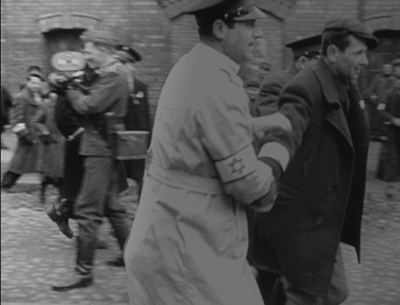
(RNS2-AUG25) A scene from “A Film Unfinished” show Nazi propaganda crews (left) filming life inside the Jewish ghetto in Warsaw. For use with RNS-NAZI-FILM, transmitted Aug. 25, 2010. RNS photo courtesy Oscilloscope.
(RNS) Perhaps the most chilling detail of the Third Reich is the precision with which it documented its own atrocities.
The timetables of trains to the death camps, the blueprints for the gas chambers, the long lists of names and numbers and ethnicities. This many arrested, this many transported, this many eliminated.
And in that precision, you hear a sick pride. Because, who else could have conceived of such an ambitious solution? Who else could have carried it out?
That mania for documentation resulted, ultimately, in the fascinating new 89-minute film, “A Film Unfinished,” built around an astonishing bit of found footage — “The Ghetto,” the Reich’s own filmed record of its brutal reign in Warsaw.
There is only about an hour of it, but around it Israeli filmmaker Yael Hersonski has built a striking feature.
There is, occasionally, some too-artily-shot new transitions, some flatly written narration. But then we see the original movie. We hear the testimony of those who saw it being filmed. And we watch, heartbreakingly, as a few aged survivors see it now, for the first time.
Why didn’t the Germans ever finish their movie, and what was even the point of making it? Those answers were lost long ago in the twisted maze of Nazi propagandist Joseph Goebbels’ mind.
At times, the Reich’s film tries to deny the regime’s anti-Semitism, with staged scenes showing “happy” Jews in a restaurant and a theater. At other times, it only confirms it, portraying them as filthy animals or greedy plutocrats. (For these dramatized sequences, witnesses remember, they were directed to coldly walk by real beggars, even corpses in the street.)
And all the time, the cameras whirred, capturing the manufactured “truth” (and it took effort, too — the film shows that many scenes required multiple takes). One ambitious German found some rare color stock to incorporate into the film, even bringing his own camera to help.
Yet, for all the original film’s lies, there are some inadvertent truths.
Children risking death to smuggle in a few turnips. A mother wandering the street, holding her baby, screaming for bread. A bris in a Warsaw apartment (of an infant already looking fatally frail). A mass grave outside the city, with starved bodies sliding down a long chute.
It’s at this point that one of the survivors — watching the footage, more than 60 years later, covers her face. But then she takes her hand away, and goes back to watching, intently. And so should we. Because the Nazi racists, like racists everywhere, knew without a doubt that they were right.
That’s why they made their movie. They were proud of themselves, and they wanted the world to know, and forever remember, what they had done. It is the only thing we owe them. Rating note: The film contains nudity and disturbing material.
(Stephen Whitty writes for The Star-Ledger in Newark, N.J.)




